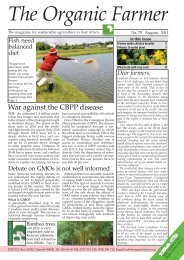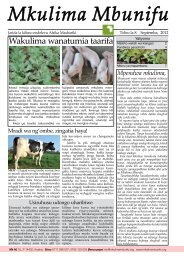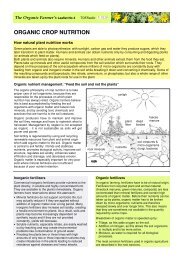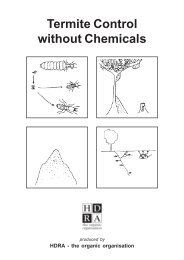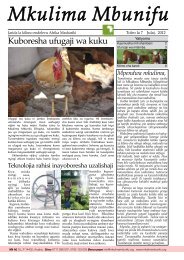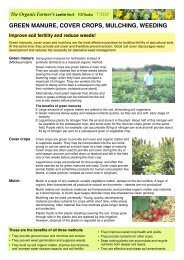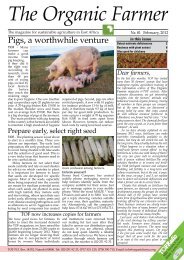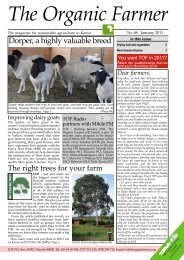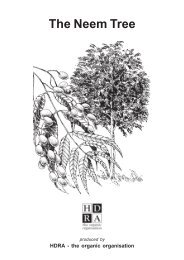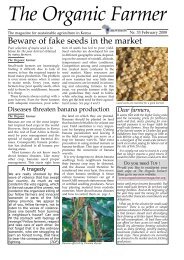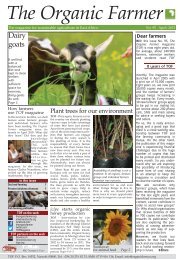Demand for rabbits growing - Infonet-Biovision
Demand for rabbits growing - Infonet-Biovision
Demand for rabbits growing - Infonet-Biovision
You also want an ePaper? Increase the reach of your titles
YUMPU automatically turns print PDFs into web optimized ePapers that Google loves.
Rabbits are easy to keep, provideyou with healthy meat and can giveyou a good income.Nr. 42 November 2008Rabbits can support your whole familyVal Corr*Many Kenyans, especially the men,would not contemplate eating rabbitmeat. However, I have always beenof the opinion that if every Kenyanfamily kept a few <strong>rabbits</strong>, their children,at least, would eat meat everyday. Rabbit meat is totally fat and cholesterolfree and has the highest proteinof all domestic livestock.Rabbits are easy to keep, cheap tofeed, breed quickly and are ready <strong>for</strong>slaughter within four months. Theycarry much more meat than a chickenof the same weight and are very easyto cook.Enough feed and waterRabbits need to feed on rabbit pelletsor rabbit ration sufficient to last themthrough the day. Green fodder is essentialbut can be fed in relatively smallquantities. There is very little that<strong>rabbits</strong> will not eat – including potatopeelings, carrot peelings and other vegetablescrap. They thrive on weeds(especially chick weed and thistles).Lucerne and Napier grass (‘thara’), if itis available.• It is essential that they receive plentyof clean water. It is a fallacy that <strong>rabbits</strong>obtain sufficient water from their food.It is surprising just how much waterthey drink in 24 hours.• Earthen ware bowls with a small lipseem to be the best <strong>for</strong> water and food,as they are too heavy <strong>for</strong> the <strong>rabbits</strong> toturn over.• It is always a good idea to putminerals in the feed (Coopers Maclickpowder is a good one).• We place a square of sacking underthe feed bowls to prevent food beingdug out of the bowl and spilt onto thefloor which is waste.Enough meatIf you decide to keep <strong>rabbits</strong> I am sureyou will find it very rewarding andit is an excellent opportunity to teachchildren about responsibility and thecare of animals – and you may be luckyenough to be able to produce enoughmeat to sell to your neighbours!*Val Corr, Lake Breeze Farm, Eburru,Naivasha. If you wish to contact her <strong>for</strong>further advice, please call 0734 913 049.Housing and beddingTo grow healthy, <strong>rabbits</strong> must be fedproperly, housed properly and keptclean. It is best to house them off theground as follows:• The house should be 90 cm offthe ground, be 90 cm high and 90 cmsquare. Because mabati comes in 2.5meter lengths, it makes sense to buildblocks of houses 1.80 meter wide sothat one sheet can be used to cover thetwo houses.• The floors should be of chickenwire so that droppings and urine fallthrough to the ground. This can thenbe swept up daily and used as compost(see end of the article).• The house should have a layer ofhay as bedding. This is a very importantpart of the <strong>rabbits</strong>’ diet; they willeat a lot of this bedding during thenight.• Rabbits must not be in windy conditions,so it is advisable to cover theends of the building with shade netsand to have ‘roll down’ shade nettingcurtains at night.How to slaughter a rabbitIt is important that the rabbit is killedvery quickly. The quickest and kindestway to do this is:• Hold the rabbit in your left handby its back legs. With your right handhold the rabbit between your indexand middle fingers, under the chinand against the base of the skull. Liftyour right hand to shoulder height,stretching the rabbit, and pull the headquickly and sharply. If you try to dothis any other way it will not work.• The rabbit should then be hung byone back leg. The head is removed.The rabbit is gutted and entrailsRabbits need clean house with adequatespace, light and com<strong>for</strong>table bedding• Their houses should be cleaneddaily. Wet bedding should be removedand put on the compost, dry hay canbe returned and some more added. If<strong>rabbits</strong> are left on soiled bedding, itis not only uncom<strong>for</strong>table but it willencourage flies which will, in turn,cause disease.removed. The feet are clipped off. Asmall slit should be made on the insideof the back leg that is not attached tothe slaughter post. The skin is peeledoff this leg. The skin is then gentlyloosened round the body and frontlegs. You will then be able to take theskin off the remaining back leg, and bypulling down, so that the skin is nowinside out, you will be able to peel theskin off like a sock.• The heads, spleens and heart makeexcellent dog food. The liver is a deliciousdelicacy and highly nutritious– your rabbit is now ready to eat.
Nr. 42 November 2008Plan the breeding and care <strong>for</strong> the youngThe doe (female rabbit) is a spontaneousovulator; it is receptive to the buckas soon as she is introduced. The doe isready to breed at 5 months. She shouldbe placed with the buck and matingwill usually take place within minutes.When she has been mated properly,the buck will twist and fall over to oneside. The doe can then be returned toher pen. It is not advisable to leave adoe with the buck <strong>for</strong> longer than 15minutes as they will both get bored. Ifshe is not mated in that time, return herlater in the day.We have had instances of ‘miraclebirths’ which are recorded in some veterinaryjournals. We have also foundthat some does, who will not acceptthe buck, are already pregnant eventhough they have not been with abuck.Important: a warm nestGestation is exactly one month and adoe will produce anything up to 10kits (young <strong>rabbits</strong>). Eight is a perfectnumber as she has eight teats; but ifwell fed, they seem to manage morewith no difficulty. Obviously, smallerlitters thrive better than large ones.Does tend to feed their young oncea day, and usually at night. A coupleof days prior to birth you will noticethat she will start collecting hay in hermouth to make a nest. She will thenpull hair from her chest and under herneck to line the nest. She will pull outmore hair after the birth and cover thebabies.Take care of young onesThis is the time that the young have tobe watched carefully:● It is essential that the babies arenot allowed to get cold, especially inthe first few days after birth. Thenests need to be checked to ensure thatbabies are not carried out of the nest bythe mother when she stops feeding. Itis quite safe to handle the young andreplace them in the nest.● The young should be weaned when amonth old. Sexing baby <strong>rabbits</strong> is notthat easy, but once you have got thehang of it, it gets easier: Hold the babyupside down in your hand and gentlyblow on the hair round the genital areaand, with two fingers, gently separatethe genitalia towards the head and tail.The males will show a small upwardprotrusion, whilst the females will onlyshow a small opening. This is easierdone with two people, one holding thebaby and the other doing the sexing.● The males and females should beseparated at this stage as they can startbreeding when they are very young.● They should then be put in separateweaning houses. A pen 90 cm x 180cm can com<strong>for</strong>tably house 6 young<strong>rabbits</strong>. Remember that there are nowmore <strong>growing</strong> <strong>rabbits</strong> in one cage, sothey must be fed adequate quantitiesof food and water if they are to growsatisfactorily.● At weaning, it is advisable to routinelytreat the weanlings with Coccidianpowder (all animal pharmaciesstock this <strong>for</strong> chickens). 1 ml per litreonce a day <strong>for</strong> 3 days should be sufficientto protect your <strong>rabbits</strong>).● It is also advisable to deworm themat this stage. Quarter ml of Albendazoladministered orally with a smallsyringe is sufficient <strong>for</strong> each rabbit. Becareful, not to put the syringe (nozzle)too far into the mouth or you maydamage the throat.● They should be ready to slaughter at4 – 5 months.Plan the breedingThree or four does to one buck wouldbe more than sufficient to keep ahousehold supplied with meat all yearround. You would there<strong>for</strong>e need:● A pen <strong>for</strong> the buck● A pen <strong>for</strong> each doe● At least two weaning pens – one <strong>for</strong>males and one <strong>for</strong> femalesIf each doe is bred to the buck at intervalsof, say, one month or longer, youwould have a continuous supply ofmeat. Depending on how many doesyou keep, you can work this out:● Gestation is one month● One month with the mother● Three months to slaughterIt is important that you plan yourbreeding – you could otherwise endup with more weanlings than you cancom<strong>for</strong>tably cope with! It is very easyto get over crowded very quickly as<strong>rabbits</strong> are very prolific breeders. –A breeding doe, if looked after andfed properly, will serve you well <strong>for</strong>approximately 4 – 5 years. A buck iffed and looked after properly couldlast you longer.It is advisable to keep a breedingsheet on the door of every doe pen.This should record her age, the dateshe is covered, date of birth, numberof kits, any deaths, date of weaning,number of kits reared. Valerie CorrValuable compostSweep all the droppings and soiledbedding into a neat, square heapevery day. If possible sprinkle withwater or, better still, with EM1. Aftertwo weeks turn it over and keep moistuntil you have a lovely dark compost.If you keep other livestock (cattle,sheep, goats, donkeys and chickens)their droppings can be added tothis compost <strong>for</strong> an even better endproduct. This would give you anendless supply of good compost <strong>for</strong>your shamba or, alternatively, a byproduct that you can sell.
Storagefrom page 2:residues. It should then be dried untilit rattles when shaken. The farmershould inspect the grain and ensurethere are no weevils. The containersshould be clean and dry. Load thegrains into the container until it is fullto the brim and close tightly. It shouldbe stored in a cool dry place.Neem and pyrethrum extractsNeem mixed with pyrethrum (knownas Nimpyr) is very effective in thecontrol of both weevils and the largergrain borer in stored maize. Howeverlarger quantities are needed (2 to 3kg/100 kg of grain). Pyrethrum has anunpleasant ordour while neem has abitter taste. This can be eliminated bysoaking the grain in water <strong>for</strong> sometimeand later washing the grains.Neem oil is especially effective whenapplied to stored beans, cowpeas andother legumes.from page 3Mycotoxinsactivation, and irradiation have beenused to minimize the adverse effects ofmycotoxins in animal industry. Someof these methods have some limitationsand so are not widely employedin the feed industry.Organic absorbentsAdsorbents are substances which,when added to feed, are capable of<strong>for</strong>ming other irreversible substanceswith mycotoxin in the intestine offarm animals. These substances are notdigestible and hence they pass downthe digestive tract and are excreted inthe faeces. Their net effect is to reducethe amount of toxin absorbed in theblood of animals to the point that isnot harmful to allow contaminatedfeed to be fed with minimal losses inper<strong>for</strong>mance.Legal limits and regulationIt is important to note that the en<strong>for</strong>cementof legal limits <strong>for</strong> mycotoxins inanimal feed is not only <strong>for</strong> protectionof the health of animals. It is even moreimportant <strong>for</strong> the protection of the consumersof any edible animal productsthat may be contaminated. The legallimits <strong>for</strong> mycotoxins reduce indirectlythe financial losses due to the adverseeffects exerted by some mycotoxinson animal productivity which is of agreat economic advantage to animalkeepers.Nr. 42 November 2008How to order your CDThe <strong>Infonet</strong>-<strong>Biovision</strong> CD containsall the in<strong>for</strong>mation that a farmer mayneed. Farmers interested in buyingthe CD only need to send us airtimeworth Ksh 200 through either our Zainline (<strong>for</strong>mer CELTEL) 0738 390 715, orthrough our SAFARICOM line, 0721541 590. After sending this airtime,please send us an SMS detailing yourfull name and correct address. We shallsend you the CD by registered mail.Magazine good <strong>for</strong> referenceRecently I visited a Ministry of Agricultureoffice and I was impressed bywhat I saw. In the waiting room was aneat spring file where monthly copiesof The Organic Farmer magazine arefiled. I opened it and found almostall issues of themagazine whereanybody interestedon any topicregarding organicfarming can maketheir reference.This filing systemgot me thinking.Every month,some of our fellowfarmers are luckyto get a copy of the magazine, but afterreading it, we simply throw it in thenearest table and <strong>for</strong>get about it. If wehave a problem on a topic which wascarried in a past issue of the magazine,then we have to wade through all thepaper work in the cupboard, the bookshel<strong>for</strong> where we stack the piles ofMagazine has becomethe farmers’ bibleThe Organic Farmer magazine is nowbeing referred to as a farmer’s bible.It is proving to be a very resourcefulpublication. Going through each copyevery month, a committed and focusedfarmer is now able to source all thenecessary in<strong>for</strong>mation from livestockto crop husbandry. On selection of marketableagricultural projects, the magazineis in<strong>for</strong>mative. Congratulationsand keep on educating us. What themagazine teaches guarantees self-sufficiencyin food production and incomesold newspapers. Often we may not getthe copy we want because it was eitherborrowed by a friend or even used byschool children to cover their books. Inother words we lose very vital in<strong>for</strong>mationthat can be used <strong>for</strong> many yearsnot only by us, butalso our children. Agood filing systemis important <strong>for</strong>such a publicationbecause we knowwe may need itlater. Right nowthere are very fewbooks on agriculturein our bookshops.The few thatyou find on sale are not relevant to ourneeds as farmers. The magazine hascome to fill this gap and we shouldtreasure and keep it in safe custody <strong>for</strong>our future reference. A small library athome can go along way to meet ourin<strong>for</strong>mation needs.John Kiarie, Kiambuto many rural households. Initially,labour is intensive and tiresome but thefruits are sweeter. With support fromWorld Vision and the magazine wehave done exemplary work in farmingand are now influencing and convertingneighbouring farmers to go intoproductive farming activities. I wouldlike to urge all concerned to adoptand religiously practise what we havelearned.John G Njoroge, 3N HarvestQuestions? Ideas?Complaints?SMS us, and we shall get back to you.0721 541 590 / 0738 390 715
Nr. 42 November 2008Earthworms are good <strong>for</strong> soil fertilityEarthworms can improve the structure,increase fertility and evenremove poisonous substances in thesoil.The importance of earthworms insoil fertility and structure cannot beoverlooked. Without them, soil wouldmost probably be compacted, infertileand perhaps even less stable and thuseasily eroded by water and wind. Sowhich are these little creatures andwhat is their role? Earth worms havebeen studied <strong>for</strong> many years; CharlesDarwin alone studied them <strong>for</strong> 36 yearsand through these studies brought theimportance of these wonderful creaturesinto the realms of science. Thereare thousands of types of earthworms.Different worms have different functions,some living within the top fewinches of the soil strata and othersliving well below. Some only operateat night and are called night crawlers.So what are the actual benefits ofthese worms?Earthworms feed on bio-degradableorganic matter. As the materials passthrough the bodies of the worms, theychange in their composition due to theaction of enzymes within the worms.Worm excreta known as ‘casts’ arevery high in plant nutrition-nitrogen,phosphorus, potassium and calcium.A word of caution here though-whatgoes in comes out. It has now beendiscovered that earth worms can alsopick up soil contaminants (includingtoxic metals), some of which they canneutralise, others remain in the worms’bodies. Strangely enough, new findingsare also showing that earthwormsare one of the fastest creatures to adaptto contaminants in the environmentand pollution. They actually breedbetter and live longer in areas that aremost contaminated!These contaminants could be frompesticide or fertilizers, hormones andantibiotics found in animal manureor other plant material. In the case ofcleaning up contaminated soils, earthwormsare now playing a major rolljointly with plants that have the capabilityof extracting soil contaminants.The worms process the contaminantsin the soil and make them available<strong>for</strong> plant uptake. There is even talkof smelting these plants to extract themetals <strong>for</strong> reuse in industry! So apartAn earthworm (above) compost madeusing earthworms (below). (Photos TOF)from the magic of improving the soilfertility by burrowing and creatingwater and air passages, breaking downbio-degradable matter into easily accessibleplant nutrition and improving thesoil structure, earthworms also help toclean polluted soil. They are really fantasticcreatures. Here are guidelines onhow farmers can make the most use ofearthworms in organic agriculture:Attract the indigenous worms intoour fieldsTo do this we need to understand bothwhat earthworms require and whatrepels them. They require damp soilwith a lot of decaying plant material.I emphasise damp because wormscannot move through dry soil. Theyeither die or tend to travel towards thedamp soil. They do not like dry soil, orsoil that is humus-free. They are eatenby ants (siafu)) and birds, they there<strong>for</strong>eneed sheltered areas. Simply put,land that is mulched, damp and hasa lot of plant material incorporated inthe top 1 foot of soil will be a heaven<strong>for</strong> earthworms. Crops produced inthis area should flourish. Note thatearthworms do not normally feed on<strong>growing</strong> plants, seeds, seedlings etcCreate artificial wormeriesHere we create a small- scale heaven<strong>for</strong> the worms, allowing them to breed,eat and excrete safely under controlledconditions. Most wormeries are about1-1.5 feet deep .They allow <strong>for</strong> drenchingof the system with water and collectionof the same water now termedas worm juice or worm tea. This juice isthen diluted and used as a plant foliarfeed.Makes leaf mouldLeaf mould broken down by earthworms is extremely nutritious <strong>for</strong>plants. As you can imagine, the nutrientsin leaves are collected from a soildepth most plants would be unable toreach. To produce leaf mould, simplyfill a sack (gunia) with leaves, fresh aswell as dry and leave in a shaded place.Make sure the leaves are damp andnever dry out. Add a few earth wormsand leave them to do their work. In afew months, depending on the amountof worms in the system, you will havea wonderful plant food. One thing tonote: Earthworms are cold composters,do not try to add them to a compostpile that is too big and expected to heatup. However, do expect to find earthwormsinhabiting a compost pile thathas gone through its heating phase andis now completely cool. Su KahumbuDestructive earthwormsIn the past few months, new findingsare beginning to reveal the destructivenature of some earthworms. It issaid that in the US, exotic earthwormsare infact feeding on delicate <strong>for</strong>estmosses threatening the extinction ofthis moss and resulting in degradationof the top soil. It is feared thismay result in the extinction of otherdelicate soil organisms and thus thefertility of the <strong>for</strong>est soil in the future.Note: These worms are exotic andnot indigenous. So as we utilise thebenefits of these worms locally, let uskeep in mind the likely damage theycan cause if we were to introduceexotic worms into our soils. SK
Nr. 42 November 2008Save your beans from destructive pestsOne of the majorcauses of bean lossduring storage isdamage by grainweevils (bruchids).Bruchids drill holesand feed within thebeans, leaving themwith many holesand low weight.Control methods:1. Mix the dry beansgrain with woodash <strong>for</strong> every 90 kgbag of beans.2. Mix a teaspoonfulof corn oil likeElianto <strong>for</strong> every 1kg tin of beans.Sunning and sievingIf you have 1 or 2 bags of beans andyou live in an area with adequatesunlight, drying the beans and thensieving them kills the eggs andlarvae and makes the adults to flyaway. For this methodto be effective, farmersshould do the following:• Spread out thebeans in a mat underthe sun <strong>for</strong> about 6hours.• After sun drying,sieve them using anordinary kitchen wiresieveDuring the first 3months after harvest,sieve the beans onceevery 2 weeks. After3 months, sieve thebeans once every 3weeks. The method not only savesmoney. The beans are not harmed ordamaged and they germinate wellif they are used as seed. The taste ofthe beans is not affected and thereis no risk of poisoning from use ofchemical pesticide.Diatomite can control pestsDiatomite is white powder made up ofmillions of fossilised microscopic plantscalled diatoms,which havesharp edgesthat pierceinsects killingthem. It is oneof the mosteffective natural pest control compoundsthat does not affect the quality of grains andis not harmful to both humans and animals.Diatomite is mined at Gilgil by the AfricanDiatomite Industries. A 20 kg bag retails atKsh 350. A ½ kg of the powder is enough toprotect 1 bag of maize, wheat, oats, rice oreven sorghum. It is applied directly to thegrain and mixed with a shovel. Diatomiteshould be washed off and the grain driedbe<strong>for</strong>e consumption. Farmers interested cancontact African Diatomite Industries P.O Box32 Gilgil Tel. 050 401 209, 050-401 5209Mobile Tel.0722 277 120Issue 5, November 2008To advertise contact: James Wathuge 020 356 4106, 0720 419 584, 0733 893 300, email: thefarmersclassified@mailnew.com.comFarmer’s DiaryBrookside dairy farmers training days:Month Date Venue DistrictOctober 31 Mundoro Gatundu SouthNovember 7 Sabatia D.F.Coop KoibatekNovember 21 Kathangariri EmbuNovember 28 Tetu Nyeri SouthDecember 5 Sotik D.F.C.Soc BuretCONTACT PERSON: S.N. KARIUKI 0733 - 270986



